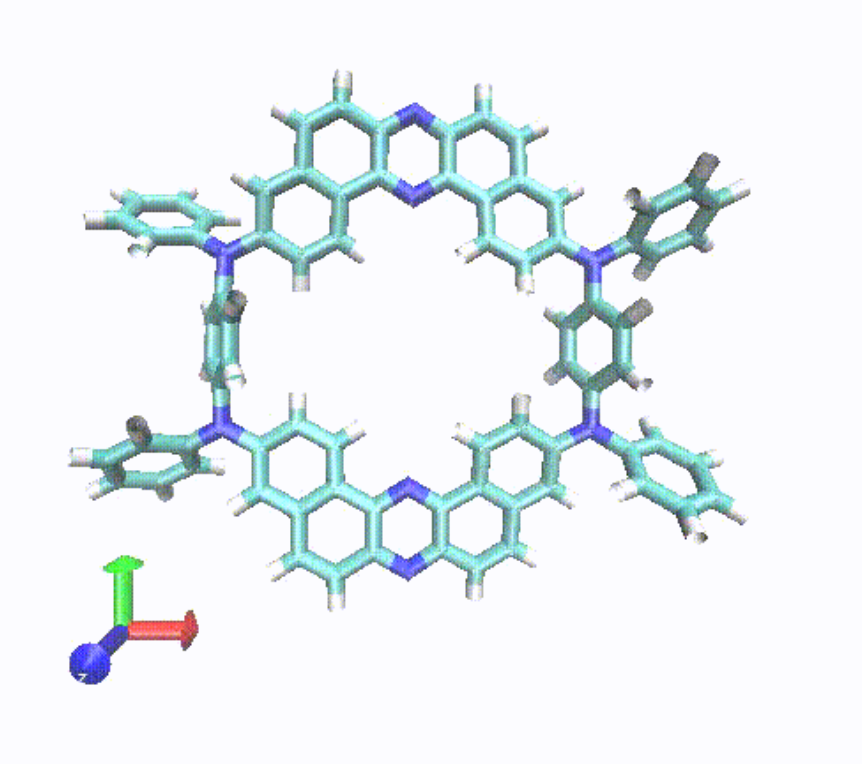
Author: Xiao Rou Liew
Mentor: Elliot Taffet
The Alice Smith School Kuala Lumpur
Abstract
In recent years, quantum mechanics has driven the exploration of electronic spin, a fundamental concept in the realm of particle physics. The manipulation of electron spin opens up a realm within optoelectronics, enabling efficient conversion between electronic charge and electromagnetic radiation, based on electronic transitions (the triplet and singlet states). This research seeks to understand and advance organic light-emitting diodes (OLEDs), and their utilization and optimization of the photophysical mechanism of thermally activated delayed fluorescence (TADF). Synthetic strategies for TADF optimization encompass efficient intramolecular spin-crossover mechanisms, including linear polymers and macrocycles. Understanding this multimolecular interplay, encompassing geometries, and excitonics resides in the use of advanced theoretical and computational methods – one that is usually too expensive or complicated to execute. To address these challenges, this research paper will employ a spin-generalized ab initio exciton model (GAIEM) to investigate interunit interactions within macrocycles, with the inclusion of locally excited (LE), charge transfer (CT), and triplet pair (TT) electronic structures underlying spin-singlet and spin-triplet excited states. An important aspect to be explored in this paper is the distinguishability of triplet states by LE and CT character, as well as the energetic proximity between these states. Additionally, the coupling of electronic states will be explored using the two-hole variation of the Tamm and Dancoff Approximation (hh-TDA). This research paper promises to shed light on the complex interplay between quantum spin and optoelectronics, offering valuable insights for the development of future optoelectronic devices and applications.
Introduction
Recently, scientists have been hauled up by quantum mechanics: deciphering the concept of electronic spin. But what is electron spin? Electron spin is the idea that electrons exist as pairs within spatial orbitals through an antiparallel alignment with respect to a magnetic field. But the manipulation of spin opens up a world of possibilities within the realm of optoelectronics – the efficient conversion between electronic charge and the electromagnetic radiation that is based upon electronic transitions. By revealing the mysteries surrounding quantum spin, it could help design the next generation of optoelectronic devices.
Can spin-crossover be controlled at the level of chemical synthesis such that more charge can be channeled toward radiative recombination from electronically excited states? And are there achievable multimolecular assemblies that can be engineered to execute this optoelectronic function through fine-tuning their chemical-bond framework rather than just relying on clumping of individual molecules? These questions lie at the heart of organic light-emitting diodes (OLED) leveraging the photophysical mechanism of thermally activated delayed fluorescence (TADF). TADF requires thermal activation of the spin-crossover from electrically excited triplet to photoexcited singlet states, which results in a delay of radiative recombination following the rate-limiting step of singlet excitation. TADF is grounded in the fourfold multiplication (the amount of substates one can get from a triplet and singlet spin) of emitted photons of light from a 3:1 spin-statistical distribution of triplet:singlet excitations – dramatically improving OLED efficiency (Nobuyasu et al., 2016). Synthetic strategies toward TADF optimization have been discovered from efficient intramolecular mechanisms of spin-crossover to multimolecular methods that enable the fabrication of devices. These methods include linear polymers and macrocycles.
Macrocyclic TADF is fascinating due to the interplay between the units of chemically connected donors (D) and acceptors (A). These donor and acceptor units of excited electron density alternate around a two-dimensional ring. Chemically engineering this macrocycle creates both excitonic effects of delocalization across multiple units of D and A as well as control of the DA architecture (Izumi et al., 2020). Modelling and understanding this multimolecular interplay at the level of geometries and excitonics requires advanced theoretical and computational methods. Theories that stretch beyond the single molecule in resolving excited-state electronic structure are key in the description of excitonic effects when modeling multiunit macrocycles. Moreover, theories that provide finer results of not only the interplay between the individual units but also the electronically excited states they support will become important when modeling the molecular dynamics of the TADF mechanism.
To address this, we will implement a spin-generalized ab initio exciton model (GAIEM) to understand interunit interactions in macrocycles, including locally excited (LE), charge transfer (CT), and triplet pair (TT) electronic structures underlying the spin-singlet and spin-triplet excited states (Li, Parrish and Martínez, 2020). A central question regarding macrocyclic mechanisms of TADF is the extent to which the manifold of triplet states is distinguishable by LE and CT character as well as the energetic proximity between these states. Thus, quantum-chemical calculations will help us unravel these spin manipulating mysteries (Hall et al., 2023). Additionally, the coupling of electronic states through both their configurational character and vibrational activity – the way spin-crossover is thermally activated – will be explored using the hole-hole variation of the Tamm and Dancoff Approximation (hh-TDA) to time-dependent density functional theory (Bannwarth et al., 2020). This is because using hh-TDA offers a more in-depth level of electronic correlation that cannot be reached by particle-hole TDA.
Methods
A. Ground state optimization
In order to analyse molecules at an excited state, we first needed to understand how the molecule behaves at equilibrium – which is also known as the ground state. For the first part of our calculations, we are finding out the ground state nuclear geometry at equilibrium. The ground state is where the molecule sits before it is stimulated by electricity or by light.
To calculate this optimization I chose the functional CAM-B3LYP considering the 6-31G (d,p) basis set. This level of theory is suitable for the calculations because not only does it have a wide range of excited-state natures to analyse, but the functional CAM-B3LYP is known to cure the large destabilisation of the CT states which is observed using other functionals such as B3LYP and PBE0 (Hall et al., 2023). Then with my chosen level of theory, we ran computational quantum calculations to find out the equilibrium geometry of these molecules.
B. Singlet-triplet excited state gap
After calculating the equilibrium geometry of the molecules, we are now able to determine the manifold of electronically excited states; in other words the singlet-triplet gap – which is a representative of how the molecules are excited based on the equilibrium geometry.
To calculate the singlet-triplet energy gap, we used a very similar method to what was used in the article Hall et al., 2023. However, we used a very different system to find our energy gap and used macrocycles – the 2D ring consisting of alternating donor-acceptor molecules – instead (which is more extensive to what Hall et al., 2023 considered in their paper).
C. Triplet excited state optimization
While the calculation of the singlet-triplet energy gap is sufficient enough for us to conclude the manifold of electronically excited states, we decided to take it one step further and analyse the complicated triplet state. Thus, for this last section of calculations, we are trying to optimise the geometry of the triplet state, reflecting what will happen if we electrically stimulate this molecule. In short, we are trying to find out what happens to the triplet after it is excited.
In definition, excitation is the instant in time in which we stimulate an electron to go to the triplet state from the ground state. However, in reality the instant the electron is excited there is no opportunity for the nuclei of that molecule to change positions. Therefore, it is frozen in that instance in time. Thus, we have to subsequently relax the nuclei as the electrons respond to an excitation; and that response is reflected in the triplet excited state geometry optimization.
Results
A. Ground state optimization
First, we need to understand how the molecule behaves at equilibrium. We found out that after 43 cycles, the equilibrium geometric optimization converged – meaning that the nuclear geometry had reached equilibrium. This means that all the values in the 43rd cycle were smaller than the criteria values for ΔE (1.000 x 10-6 J), the gradient RMS (3.000 x 10-4), the gradient maximum (4.500 x 10-4 J), the displacement RMS (1.200 x 10-3 J) and the displacement maximum (1.800 x 10-3 J), respectively.
The further away the value was from the criteria, the weaker the convergence. When there is a difference between iterations of a) the energy, b) the nuclear forces, and c) the nuclear positions, there is a very poor quality of convergence.
Overall, each cycle progressively got closer to the criteria values. As expected, the first 5 cycles of results were well above the criteria level (ΔE: -1.209 x 10-4 J, gradient RMS: 3.434 x 10-4 J, gradient maximum: 9.956 x 10-4 J, displacement RMS: 3.684 x 10-2 J, displacement maximum: 6.754 x 10-2 J after the 5th cycle), indicating that the geometric optimization is still far from the equilibrium. The following 5 cycles gave similar outcomes.
By the 20th cycle the values for ΔE, the gradient RMS, and gradient maximum reached above the criteria values: -7.788 x 10-8 J, 3.809 x 10-5 J, and 9.641 x 10-5 J respectively. The values for both the displacement RMS and displacement maximum had not exceeded the threshold yet. However, between cycles 25 and 30 the value for
ΔE went below the threshold (-4.865 x 10-5 J) and continued to do so followed by the values for gradient maximum (6.818 x 10-4 J) – note that both values were taken by the end of the 30th cycle. Once again, the values for ΔE (3.585 x 10-7 J), gradient RMS (4.878 x 10-5 J), and gradient maximum (1.221 x 10-4 J) exceeded the criteria values by the 37th cycle (17 cycles later). Nearing the last few cycles, the value for displacement RMS finally exceeded the criteria value (by the 39th cycle) with a value of 1.175 x 10-3 J. Finally after 43 cycles all the values exceeded the criteria values, resulting in our final nuclear geometry.
The final values are as follows: -2.275 x 10-7 J (ΔE), 7.164 x 10-6 J (gradient RMS), 2.402 x 10-5 J (gradient maximum), 6.079 x 10-4 J (displacement RMS), and 1.566 x 10-3 J (displacement maximum).

B. Singlet-triplet excited state gap
These next set of results were based on the ground state geometry results we calculated above. But instead of solely finding out the ground state equilibrium, we must calculate the absolute excitation energies of both the triplet and singlet state in order to accurately calculate the singlet-triplet excited state gap.
We found out that at the triplet excited state the energy was 2.61 eV and at the singlet excited state the energy was 3.12 eV. This creates a gap of 0.51 eV based on the ground state optimised geometry.
Based on these results, we concluded that from the ground state to the triplet optimised geometry the gap from the triplet excited state to the singlet ground state has closed; but, the gap from the triplet excited state to the singlet excited state is widening. This is because as the triplet falls further to the ground state – meaning that the triplet moves further away from the higher excited state – the gap between the triplet and the higher excited state increases. Therefore, we can explain the cause of this closing and widening of the singlet-triplet gap through the triplet geometric optimization.
C. Triplet excited state optimization
With this final step of calculations, we are trying to follow the triplet to its equilibrium position in terms of the nuclei. Based on the results from the calculation we can identify that the resulting gap from triplet to singlet actually represents the phosphorescence emission gap. This is when the triplet equilibrium occurs after excitation – allowing the triplet to relax – and from that position it will emit back down to the (singlet) ground state – this is radiation that we call phosphorescence (spin forbidden). We call this the phosphorescence emission energy.
Based on our results, we found out that after triplet geometry optimization, the triplet state lies 2.02 eV above the ground state and the singlet state lies 2.91 eV above the ground state at this geometry. Comparing these results to our previous set of results, we can see that both the triplet and singlet state energy decreased from 2.61 eV to 2.02 eV and 3.12 eV to 2.91 eV, respectively. This is due to the triplet energetically stabilising itself; hence, lowering the energy gap towards the ground state as the triplet relaxes.
Upon observing this, we noticed a widening of the singlet-triplet gap due to the relaxation of the triplet state in equilibrium. The gap we calculated was roughly 0.90 eV. This reflects how the triplet state is being stabilised. However, in the case that the singlet state were to be stabilised geometrically we would see a closing of that gap. But with a triplet state geometrically stabilised there is a widening of that gap because the triplet falls more than the singlet upon stabilisation to its equilibrium geometry – because the triplet falls closer to the ground state.
Do take note that we are comparing the singlet and triplet results based on a fixed geometry and a fixed energy unit, eV, in order to assess the singlet triplet gap – the difference in energy in one geometry – as there is an inability to treat the singlet and triplet character on the same footing. Thus, they must be treated in a balanced way in order for us to trust the results in the energy gap.
Conclusion
Our results provide us with a very nice narrative. It allows us to see the effects on the excited states throughout initial excitation all the way to the final relaxation in the excited state manifold, all which are calculated based on the equilibrium geometry of the molecules.
For these calculations, I selected the functional CAM-B3LYP considering the 6-31G (d,p) basis set because it has a wide range of excited-state natures to analyse and cures the large destabilisation of CT states. Based on this level of theory, we observed that the equilibrium geometry was achieved after 43 cycles (the criteria was reached). Thus, we were able to calculate the absolute excitation energies of both the singlet and triplet states of the molecules during excitation, and from these energy values calculate the singlet-triplet energy gap. Surprisingly, we found that there was a closing and widening of this energy gap through the triplet geometric optimization and sought to calculate the singlet-triplet energy gap the instant we excite it from the ground state to the triplet excited state.
As we were investigating the triplet state, there was a clear closing in the singlet-triplet energy gap due to the relaxation of triplet, at equilibrium, back to ground state. We found out that that was due to the fact that the triplet falls closer to the ground state than the singlet upon stabilisation to its equilibrium geometry; thus, closing the gap between the triplet and singlet ground state and widening the singlet-triplet energy gap.
But while our results correspond with some of the results written in Hall et al., 2023, we must note that our calculations encompassed the TADF macrocycles at only one level of theory. Therefore, in order to investigate the full effects of excited-state geometric optimization we must also consider other levels of theory and the complications in handling the results of triplet character when running quantum calculations.
References
Bannwarth, C. et al. (2020) ‘Hole–hole Tamm–Dancoff-approximated density functional theory: A highly efficient electronic structure method incorporating dynamic and static correlation’, The Journal of Chemical Physics, 153(2), p. 024110. Available at: https://doi.org/10.1063/5.0003985.
Hall, D. et al. (2023) ‘Benchmarking DFT Functionals for Excited-State Calculations of Donor–Acceptor TADF Emitters: Insights on the Key Parameters Determining Reverse Inter-System Crossing’, The Journal of Physical Chemistry A, 127(21), pp. 4743–4757. Available at: https://doi.org/10.1021/acs.jpca.2c08201.
Izumi, S. et al. (2020) ‘Thermally Activated Delayed Fluorescent Donor–Acceptor–Donor–Acceptor π-Conjugated Macrocycle for Organic Light-Emitting Diodes’, Journal of the American Chemical Society, 142(3), pp. 1482–1491. Available at: https://doi.org/10.1021/jacs.9b11578.
Li, X., Parrish, R.M. and Martínez, T.J. (2020) ‘An ab initio exciton model for singlet fission’, The Journal of Chemical Physics, 153(18), p. 184116. Available at: https://doi.org/10.1063/5.0028605.
Nobuyasu, R.S. et al. (2016) ‘Rational Design of TADF Polymers Using a Donor–Acceptor Monomer with Enhanced TADF Efficiency Induced by the Energy Alignment of Charge Transfer and Local Triplet Excited States’, Advanced Optical Materials, 4(4), pp. 597–607. Available at: https://doi.org/10.1002/adom.201500689.
About the author

Xiao Rou Liew
Xiao Rou is currently in Year 13 at the Alice Smith School in Kuala Lumpur. Her academic passion lies within the realm of Organic Chemistry and Evolutionary Biology. Xiao Rou’s dream is to pursue an undergraduate degree in either Materials Chemistry or Evolutionary Biology, with a research focus for both of them.
Aside from her studies, she spends most of my time in the pool. Representing her state – Kuala Lumpur – in numerous national competitions since the age of 10, Xiao Rou aspires to continue to compete against the best in college, hoping to one day represent her country. She also loves to dance, read, and binge watch Hamilton. Nothing gets better than performing to her heart’s content!
